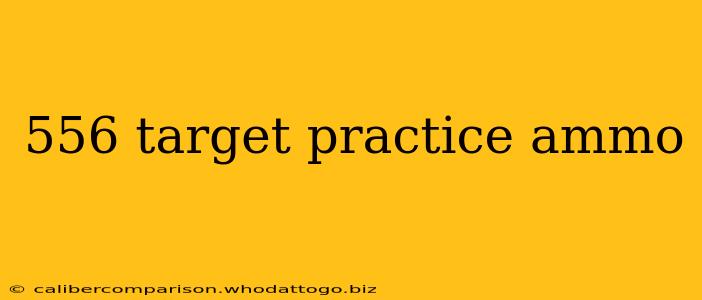Choosing the right ammunition is crucial for successful target practice. For those using the popular .223 Remington/5.56x45mm NATO cartridge, selecting the appropriate target practice ammo can significantly impact accuracy, consistency, and overall shooting experience. This guide delves into the key factors to consider when purchasing 556 target practice ammo.
Understanding .223 vs. 5.56: A Crucial Distinction
Before diving into ammo specifics, it's vital to understand the difference between .223 Remington and 5.56x45mm NATO. While often used interchangeably, they are distinct cartridges with subtle but important variations in chamber dimensions and pressure. Firing 5.56 NATO rounds in a .223 chamber can be problematic, potentially leading to damage to the firearm. Conversely, using .223 ammo in a 5.56 chamber is generally safe, though may not always produce optimal performance. Always check your firearm's specifications to ensure compatibility.
Key Factors to Consider When Choosing 556 Target Practice Ammo
Several factors determine the quality and suitability of 556 target practice ammo:
1. Bullet Weight: Finding the Right Balance
Bullet weight significantly impacts trajectory, velocity, and energy. Lighter bullets (e.g., 55 grain) generally offer higher velocities, flatter trajectories, and less recoil, ideal for beginners or those focused on speed. Heavier bullets (e.g., 77 grain) offer greater downrange energy and are often preferred for longer-range target practice due to their improved stability. The best weight depends on your firearm, range, and personal preference.
2. Bullet Type: FMJ vs. HP and Beyond
- Full Metal Jacket (FMJ): The most common type for target practice due to its affordability and consistent performance. FMJs are designed for penetration and are typically not intended for hunting or self-defense scenarios.
- Hollow Point (HP): While less common in target practice, HP bullets expand upon impact, resulting in larger wound channels (not applicable for target shooting, but relevant for other disciplines). They are generally more expensive than FMJs.
- Other Types: Various bullet types exist, such as soft points, boat tails, and match-grade, each offering specialized performance characteristics. These often command higher prices and are less commonly needed for standard target practice.
3. Ammo Manufacturer Reputation and Quality Control
Selecting reputable ammo manufacturers ensures consistent quality and performance. Established brands have rigorous quality control processes, minimizing defects and variations in ammunition. Researching reviews and comparing different brands can help identify reliable options.
4. Budget Considerations: Balancing Cost and Quality
Target practice can be an expensive hobby. While buying in bulk can often reduce the per-round cost, always prioritize quality over sheer quantity. Using low-quality ammo can lead to malfunctions and inaccurate shots, ultimately hindering your progress.
Choosing the Right Ammo for Your Needs
Selecting the appropriate 556 target practice ammo depends on several factors specific to the shooter:
- Beginner: Lighter weight FMJ rounds in bulk are a cost-effective choice to build foundational skills.
- Experienced Shooter: Exploring heavier bullets and potentially match-grade ammunition might enhance accuracy and consistency at longer ranges.
- Budget-Conscious: Prioritize a balance of quality and cost-effectiveness. Purchasing from reputable brands during sales can help optimize your budget.
Conclusion
The selection of 556 target practice ammo is a critical aspect of developing consistent shooting skills. By considering the factors outlined above and aligning your choice with your experience level and budget, you can optimize your target practice and make significant improvements in accuracy and overall proficiency. Remember always to prioritize safety and follow proper firearm handling procedures.

